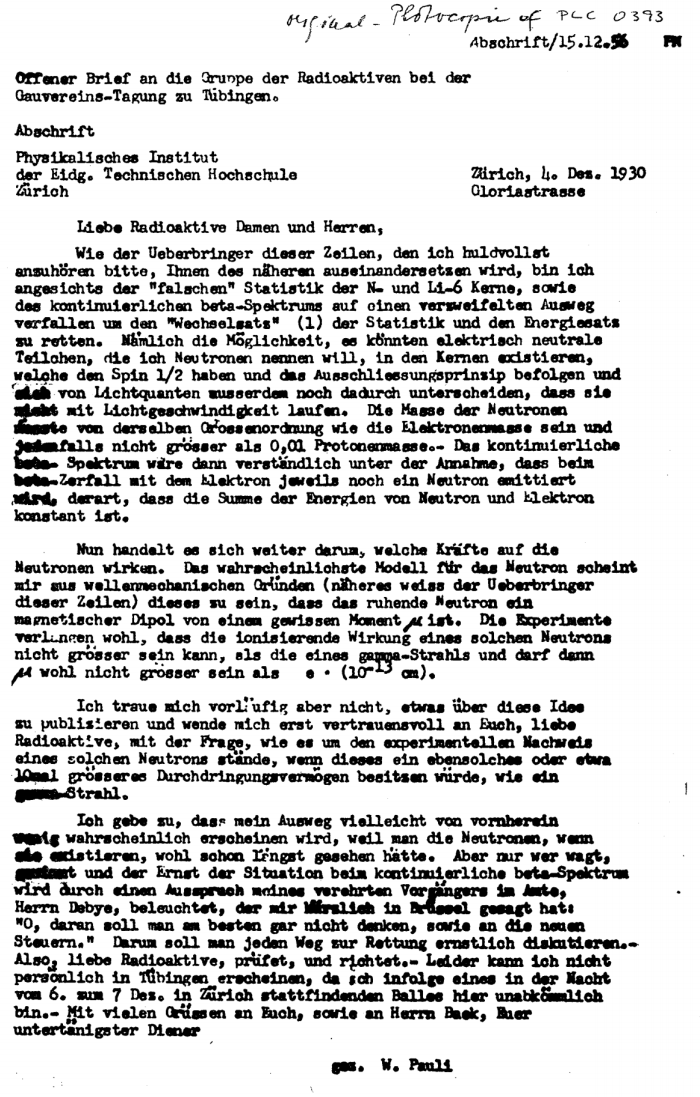The history of neutrinos
October 31, 2024If there is one thing that fits in with the Halloween theme, apart from ghosts and vampires, it's neutrinos. Well, one could argue that dark matter would actually fit better, but I needed an excuse to talk about neutrinos and their very interesting history, so neutrinos it is.
Positioned among the leptons in the Standard Model (SM), neutrinos are unique. They have an extremely small mass compared to other particles, and they interact only via the weak force, making them incredibly challenging to detect.
Despite these difficulties, a series of landmark discoveries over the course of the 20th century have revealed their existence and their different flavors, gradually broadening our understanding of these particles.
1914
The story of neutrinos begins with J. Chadwick in 1914, when he observed an apparent puzzle in beta decay. As reported in his article titled Intensitätsverteilung im magnetischen Spektren der β-Strahlen von Radium B + C, published in the Verhandlungen der Deutschen Physikalischen Gesellschaft in April 1914, the energy distribution of these decays was unexpectedly continuous (case B).
This observation was challenging the conservation of energy, a fundamental principle in physics, because the latter predicted a peak distribution for two-body decays (case A). Either this theory is wrong, which is highly unlikely, or there is another explanation. It turns out that in three-body decays, such a distribution is possible. But this, on the other hand, implies that an unseen particle participates in the decay. And no one knew at that time what this hypothetical particle could be.
1930
In a letter he wrote in December 1930, W. Pauli made a daring proposition. To explain the missing energy in beta decay, he hypothesized the existence of a nearly massless, neutral particle, called Neutronen, i.e., neutron.
Later renamed as neutrino (meaning little neutral one in Italian), Pauli's particle was intended to preserve the principle of energy conservation in beta decay. One fear he had though was that it would be forever undetectable due to its elusive nature.
1934
Pauli's neutrino concept remained theoretical until 1934, when E. Fermi built a detailed mathematical theory around it. In his paper titled Versuch einer Theorie der β-Strahlen, published in March 1934 (Z. Physik 88), Fermi described how a neutron could decay into a proton, an electron, and this new neutrino. His work mathematically grounded Pauli's concept and integrated it into the broader framework of particle interactions. Despite Fermi’s theory, neutrinos remained at that time purely theoretical.
1956
In 1956, C. Cowan and F. Reines conducted an experiment that would finally make neutrinos more real than ever. Using a nuclear reactor at the Savannah River Plant in South Carolina, as reported in their first article titled Detection of the Free Neutrino: a Confirmation published in July 1956 (science.124.3212.103), they detected the electron neutrino by observing the products of antineutrino interactions. A full account of their experiments was later published in January 1960 in a paper titled Detection of the Free Antineutrino (PhysRev.117.159).
This groundbreaking observation confirmed Pauli's particle and opened the door for experimental neutrino physics. On 15 June 1956, having been notified by telegram of this discovery, Pauli wrote to Reines and Cowan, Thanks for the message. Everything comes to him who knows how to wait.
1962
With the electron neutrino established, physicists began to investigate whether neutrinos might exist in different flavors. In 1962, M. Schwartz, L. Lederman, and J. Steinberger discovered a second type of neutrino at Brookhaven National Laboratory: the muon neutrino. Using a high-energy particle accelerator to create a beam of neutrinos, they detected interactions that distinguished the muon neutrino from the electron neutrino. The whole process is detailed in their paper called Observation of High-Energy Neutrino Reactions and the Existence of Two Kinds of Neutrinos, published in July 1962 (PhysRevLett.9.36). Two flavors were therefore confirmed by experiments, but could there be more?
1989
In 1989, four experiments at CERN’s Large Electron-Positron (LEP) collider suggested the existence of a third neutrino. These experiments were ALEPH, DELPHI, L3 and OPAL. By measuring the invisible decay width of the Z boson, LEP experiments inferred that there were three types of light neutrinos, or more exactly 3.10 ± 0.04 as reported in an article titled Measurement of the Z0 mass and width with the opal detector at LEP published in November 1989 (Phys.Lett.B.0370-2693(89)). This result represented the average of the four above experiments, each giving respectively the following measurement: 3.27 ± 0.30 (CERN-EP/89-132), 2.4 ± 0.6 (CERN-EP/89-134), 3.42 ± 0.48 (CERN-L3/001), and 3.1 ± 0.4 (CERN-EP/89-133).
Interestingly, a final report of the LEP experiments published in September 2005 in an article titled Precision Electroweak Measurements on the Z Resonance (j.physrep.2005.12.006) presented a value of 2.9840 ± 0.0082
2000
Predicted by the experiments conducted at CERN’s LEP, the tau neutrino was finally observed in 2000 by the Direct Observation of the Nu Tau (DONUT) experiment at Fermilab. This experiment provided direct evidence of the tau neutrino’s interactions, completing the set of three known neutrino flavors in the Standard Model.
As described in their paper titled Observation of tau neutrino interactions published in April 2001 (Phys.Lett.B504:218-224,2001), the existence of tau neutrinos was inferred by observing that a tau particle was the only lepton produced at the primary vertex (PV), resulting from the interaction of tau neutrinos. This tau was especially confirmed by its subsequent decay into lighter fermion or hadrons.
With this last discovery, the identity of all known neutrinos was confirmed.
Additionally, it is worth noting that shortly after the first observation of the electron neutrino was announced, two important papers mentioned or postulated that neutrinos could change their flavor, creating oscillations. But this will be a subject for another article.
